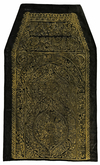Lot 320 A RARE MAGHRIBI GILT-METAL THREAD EMBROIDERED CURTAIN OR COVER, NORTH AFRICA, MOROCCO, 17TH CENTURY
Of rectangular form, the black cotton ground embroidered with gilt-metal threads, the design comprised of an arched inscription band with an inner ogee arch centred on a small calligraphic roundel with starburst surround and a larger leaf-shaped cartouche below enclosing a monumental radial inscription, the spandrels with crescent-form calligraphic cartouches, the interstices with leaf scrolls, flowerheads and further inscriptions, the tapered upper section with two broad inscription bands in oblong cusped cartouches, framed by a narrow scrolling border, modern backing.
Embroidered section: 184 by 112 cm.
On backing: 207 by 131 cm. max.
Inscriptions:
The top cartouche: Qur'an, surah al-Tawba (IX), parts of 128 and 129.
In the corners of the second cartouche: 'God' and 'Muhammad'
In the two roundels in the corners of the main arch: The shahada.
In the main arch: Qur'an, surah al-Baqarah (II), 260, ending with: 'The Most Supreme God told the truth'.
In the inner arch: Qur'an, surah al-Baqarah (II), parts of 137; surah Al 'Imran (III), parts of 102.
In the roundel in the inner arch: Qur'an, surah al-Saff (LXI), parts of 13.
In the large cartouche: Qur'an, surah al-Ikhlas, (CXII).
In the centre of the large cartouche: Qur'an, surah al-Duha (XCIII), 5.
In the border around the central cartouche, the upper part: A couplet from al-Busiri's Qasida al-Burda.
The lower part, suggested reading:
A mulay ya idris ibn nabiyyana wa malja' hadha al-qutr fi'l-'usr wa'l-yusr / taka (?) nafsi bi-burd sawarif atayni 'ala talf li-marrat tughashshani 'ala furan
In the leaf-shaped cartouches: Invocations to God.
This beautiful textile is a rare survival belonging to a small corpus of Maghribi textiles produced in North Africa, probably Morocco, for Mecca or with a connection to the Hajj, perhaps as early as the seventeenth century.

